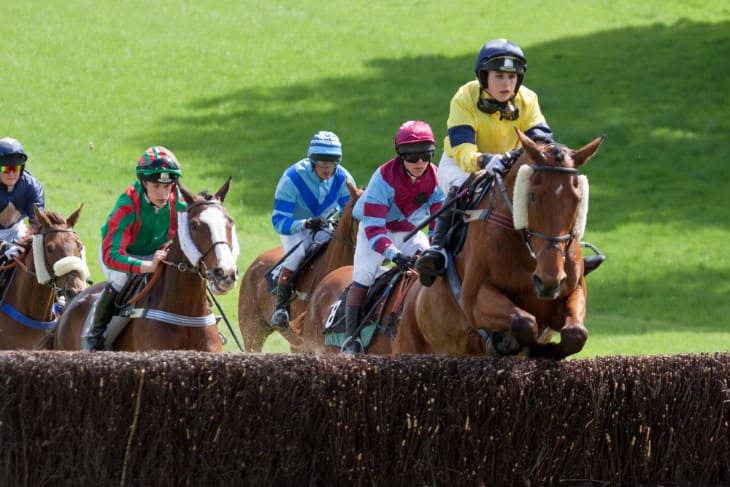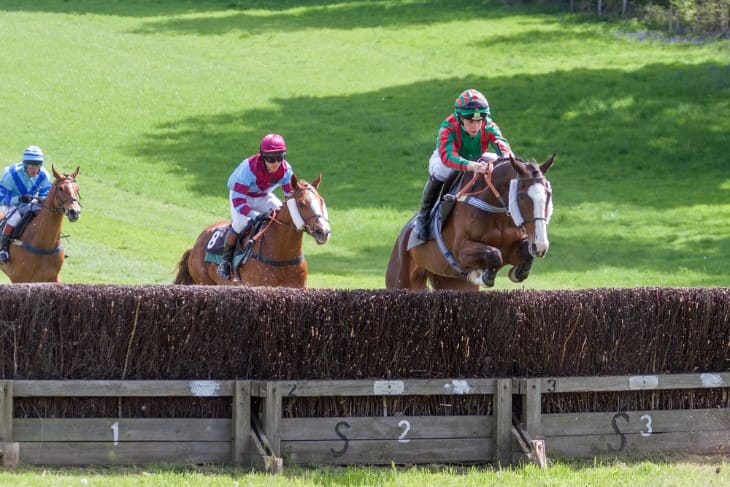- Point-to-Point Horse Racing
- Historical Evolution of Point-to-Point Racing in the UK
- The Role of Local Hunt Committees and Organizing Races
- The Distinctive Characteristics of Point-to-Point Tracks
- Breeds and Training: Horses Competing in Point-to-Point Races
- The Thrill of Point-to-Point Spectatorship
- Jockeys and Trainers in the Point-to-Point Circuit
- Challenges and Opportunities in Contemporary Point-to-Point Racing
- Point-to-Point Racing and the Surrounding Rural Community
- Conclusion: Preserving Tradition in the Modern Era of Horse Racing
In the UK, horse racing often evokes thoughts of esteemed events like the Royal Ascot or Cheltenham. Yet, beyond these prominent races exists the traditional Point-to-Point horse racing. This article will provide a comprehensive overview of Point-to-Point racing, detailing its historical context, organisational structure, participants, and its pivotal role in the British equestrian framework.
Point-to-Point Horse Racing
At its core, Point-to-Point horse racing represents a departure from the grand stages and high-stakes wagering often associated with professional horse racing. Instead, it embraces a rustic charm, harking back to a time when horse racing was as much about local camaraderie as it was about fierce competition. These races are held on local courses across the countryside, turning the spotlight onto the talents of amateur jockeys and locally trained horses. It's a stark contrast to the world of professional racing, where million-pound bets and celebrity trainers often take centre stage.

Historical Evolution of Point-to-Point Racing in the UK
Point-to-Point racing has its roots firmly embedded in the British countryside. Its origins trace back to the 19th century when foxhunting was a widely popular pastime among the landed gentry. After the day's hunt, riders would often engage in impromptu races, a way to showcase the prowess of their horses and their own riding skills. These informal races evolved into more organized events, gaining momentum within local communities.
The first recorded Point-to-Point race, as we know it today, took place in Leicestershire in 1836. What started as a friendly competition among neighbours soon grew into a fixture of rural life. Over time, Point-to-Point races became a bridge between the traditional foxhunting culture and the growing popularity of horse racing as a sport. This transition was further solidified with the establishment of the National Hunt Committee in the early 20th century, which sought to regulate and standardize Point-to-Point racing, allowing it to flourish beyond local boundaries.
The Role of Local Hunt Committees and Organizing Races
Central to the essence of Point-to-Point racing are the local hunt committees that take on the responsibility of organizing these events. These committees serve as the linchpin, orchestrating everything from course preparation to ensuring the safety of riders and horses. With a strong connection to the equestrian community, these committees bring together enthusiasts and volunteers, each contributing their skills to make each race day a success.
The process of selecting a location for the racecourse is meticulous. The track must offer a balance between challenging jumps and a safe environment for both horse and rider. Committees work closely with landowners to secure the right terrain and navigate the complexities of logistics and permissions. Often, these racecourses are temporary, constructed with care to minimise their impact on the environment.
The Distinctive Characteristics of Point-to-Point Tracks
Unlike the well-manicured tracks of mainstream horse racing, Point-to-Point courses exude a distinct rural authenticity. The tracks vary in length and design, shaped by the contours of the land and the natural obstacles present. Hay bales, post-and-rail fences, and open ditches are scattered along the course, providing jockeys with a series of formidable jumps to conquer.
One of the most notable aspects of Point-to-Point tracks is the absence of permanent structures like grandstands. Spectators gather along the edges of the course, often separated from the action by little more than a low rope barrier. This proximity offers an up-close and personal experience, where the sound of galloping hooves and the sight of horses in full flight create an electrifying atmosphere.
Navigating these tracks requires a unique combination of skill, strategy, and an intimate understanding of the horse's capabilities. It's an artform that showcases the deep connection between rider and steed, where trust is paramount as they negotiate the challenges that Mother Nature and the course present.
Breeds and Training: Horses Competing in Point-to-Point Races
The horses that grace the Point-to-Point tracks come from a diverse range of breeds, but they all share one common trait: the ability to handle the rough and unpredictable terrain that characterizes these races. While Thoroughbreds are a common sight, the field also includes Irish Draughts, Connemaras, and other breeds renowned for their agility and stamina.
Training a Point-to-Point horse is a labour of love that involves a close partnership between the trainer and the animal. Unlike the regimented routine of professional racing yards, Point-to-Point trainers often operate from their own stables, pouring personal attention into each horse. Conditioning is centred around preparing horses to tackle various jumps and terrains. The bond between horse and trainer is tangible, as they work together to build strength, hone technique, and develop a thorough understanding of the course's challenges.
The Thrill of Point-to-Point Spectatorship
In the world of Point-to-Point racing, spectators are not just passive observers; they are an integral part of the experience. Imagine standing in the countryside, wrapped up against the brisk air, the scent of damp earth and horse sweat mingling in the atmosphere. The excitement builds as the crowd collectively holds its breath, waiting for the first glimpse of horses and jockeys emerging from the distance.
As the race unfolds, the spectators become part of the drama. Cheers and shouts fill the air, urging on their favourites, willing them over the jumps, and sprinting towards the finish line. This communal spirit, the shared camaraderie among friends, families, and fellow racing enthusiasts, is what distinguishes Point-to-Point spectatorship from the grandstands of high-profile racecourses.
Jockeys and Trainers in the Point-to-Point Circuit
At the heart of every Point-to-Point race are the jockeys who guide their horses through the twists and turns of the course. Unlike professional racing, where seasoned jockeys are commonplace, Point-to-Point events often see amateur riders in action. These enthusiasts, sometimes even the horse's owners or trainers, have a deep passion for the sport and a genuine love for the animals they ride.
The jockey's role extends beyond mere riding skill; it's about forming a symbiotic connection with the horse. The terrain can be unforgiving, demanding split-second decisions and a fine-tuned understanding of the horse's abilities. The jockey must become an extension of the horse, anticipating its movements and responding to its cues as they both navigate the challenges of the course.
Behind every successful jockey is a dedicated trainer. Point-to-Point trainers are a unique breed themselves. Their days often start at dawn, tending to the needs of the horses, overseeing training routines, and ensuring the overall well-being of the animals in their care. This hands-on approach, combined with a deep understanding of equine physiology and psychology, allows trainers to tailor training regimens to the individual needs of each horse.
Challenges and Opportunities in Contemporary Point-to-Point Racing
While Point-to-Point racing thrives on tradition, it also faces modern challenges. As urbanization encroaches on rural landscapes, securing suitable racecourse locations becomes increasingly difficult. The financial burden of maintaining these temporary tracks and the lack of infrastructure present hurdles for local hunt committees and organisers.
Yet, despite these challenges, Point-to-Point racing offers a unique set of opportunities. It remains a bastion of amateurism and community involvement, a refreshing contrast to the commercialism of professional racing. Its intimate setting fosters connections between riders, trainers, owners, and spectators, creating a sense of belonging and shared purpose.

Point-to-Point Racing and the Surrounding Rural Community
Point-to-Point racing isn't just about horses thundering around a track; it's an integral part of the fabric of rural life. These events bring communities together, offering a chance to celebrate local culture, forge connections, and support charitable causes. The race day is a festive occasion where families gather for picnics, trade stories, and cheer on their friends and neighbours.
The economic impact of Point-to-Point racing is also felt deeply within rural areas. Local businesses, from caterers to suppliers, find opportunities to showcase their products and services during race days. The influx of visitors injects vitality into these areas, providing a welcome boost to economies that might otherwise remain dormant.
Moreover, Point-to-Point races often act as a lifeline for charitable causes. Many events choose to donate a portion of their proceeds to local charities, hospitals, or community initiatives. It's a way for racing enthusiasts to give back to the very communities that host them, further cementing the bond between Point-to-Point racing and its rural backdrop.
Conclusion: Preserving Tradition in the Modern Era of Horse Racing
As we conclude our examination of Point-to-Point racing, we recognise a sport deeply rooted in 19th-century tradition, yet responsive to 21st-century demands. Point-to-Point racing underscores that horse racing isn't exclusively about prestigious events and significant bets, but is underpinned by local commitment, unity, and profound respect for the horses.
For further reading:








